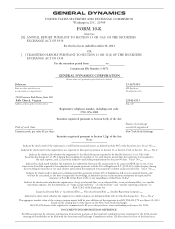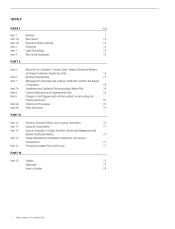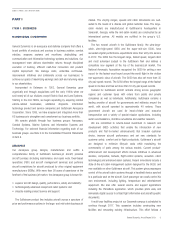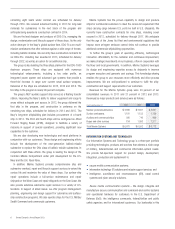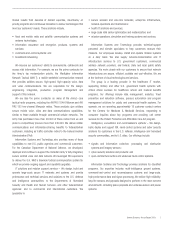General Dynamics 2013 Annual Report Download - page 12
Download and view the complete annual report
Please find page 12 of the 2013 General Dynamics annual report below. You can navigate through the pages in the report by either clicking on the pages listed below, or by using the keyword search tool below to find specific information within the annual report.
In addition, our experience in securing and protecting organizations
from network attacks has resulted in a market-leading position in cyber
security. The group offers comprehensive services and products to help
customers protect their networks from internal and external threats and
prevent data breaches. For example, we are supporting the DoD’s
Cyber Crime Center and the Department of Homeland Security’s
National Cybersecurity Protection System. We leverage this expertise to
provide investigative, forensic and network remediation services to
commercial victims of cyber attacks, including retail and financial
services firms.
Information Systems and Technology also has a 50-year legacy of
providing advanced fire-control systems for Navy submarine programs
and is developing and integrating commercial off-the-shelf software
and hardware upgrades to improve the tactical control capabilities for
several submarine classes. Capitalizing on this expertise, we developed
the combat and seaframe control systems and are the lead systems
integrator for the Navy’s Independence-variant Littoral Combat Ship
(LCS) and the electronic systems for the Navy’s Joint High Speed
Vessel (JHSV).
The group is well-positioned to continue meeting the needs of our
diverse customer base. We are continuing to improve performance
across the portfolio by optimizing the size of the business while
developing innovative solutions to meet evolving customer
requirements.
Revenues for the Information Systems and Technology group were
34 percent of our consolidated revenues in 2011, 32 percent in 2012
and 33 percent in 2013. Revenues by major products and services
were as follows:
Year Ended December 31 2011 2012 2013
Mobile communication
systems $ 4,511 $ 3,425 $ 3,657
IT solutions and mission
support services 4,601 4,545 4,734
Intelligence, surveillance and
reconnaissance systems 2,109 2,047 1,877
Total Information Systems and
Technology $ 11,221 $ 10,017 $ 10,268
CUSTOMERS
In 2013, 62 percent of our revenues were from the U.S. government,
18 percent were from U.S. commercial customers, 7 percent were
from international defense customers and the remaining 13 percent
were from international commercial customers.
U.S. GOVERNMENT
Our primary customer is the U.S. Department of Defense (DoD). We also
contract with other U.S. government customers, including the
intelligence community, the Departments of Homeland Security and
Health and Human Services and first-responder agencies. Our revenues
from the U.S. government were as follows:
Year Ended December 31 2011 2012 2013
DoD $ 19,221 $ 17,217 $ 15,441
Non-DoD 2,212 2,382 2,790
Foreign Military Sales (FMS)* 1,170 1,206 1,032
Total U.S. government $ 22,603 $ 20,805 $ 19,263
Percent of total revenues 69% 66% 62%
* In addition to our direct international sales, we sell to foreign governments through the FMS
program. Under the FMS program, we contract with and are paid by the U.S. government, and
the U.S. government assumes the risk of collection from the foreign government customer.
We perform our U.S. government business under fixed-price, cost-
reimbursement and time-and-materials contracts. Our production
contracts are primarily fixed-price. Under these contracts, we agree to
perform a specific scope of work for a fixed amount. Contracts for
research, engineering, repair and maintenance and other services are
typically cost-reimbursement or time-and-materials. Under cost-
reimbursement contracts, the customer reimburses contract costs and
pays a fixed fee or an incentive- or award-based fee. These fees are
determined by our ability to achieve targets set in the contract, such as
cost, quality, schedule and performance. Under time-and-materials
contracts, the customer pays a fixed hourly rate for direct labor and
reimburses us for material costs.
Fixed-price contracts accounted for 56 percent of our U.S.
government business in 2012 and 54 percent in 2013; cost-
reimbursement contracts accounted for 39 percent in 2012 and 42
percent in 2013; and time-and-materials contracts accounted for 5
percent in 2012 and 4 percent in 2013.
Each of these contract types presents advantages and disadvantages.
Fixed-price contracts typically have higher fee levels as we assume more
risks, such as any cost overruns under our control. These types of contracts
offer additional profits when we complete the work for less than the contract
amount. Cost-reimbursement contracts generally subject us to lower risk.
Accordingly, the negotiated base fees are usually lower than fees earned on
fixed-price contracts. Cost-reimbursement contracts also can include fee
provisions that can require the customer to make additional payments when
we satisfy specific performance criteria. Additionally, not all costs are
allowable under these types of contracts and the government reviews the
costs we charge. Under time-and-materials contracts, our profit may vary if
actual labor-hour costs vary significantly from the negotiated rates. Also,
because these contracts can provide little or no fee for managing material
costs, the content mix can impact profit margins.
8 General Dynamics Annual Report 2013





